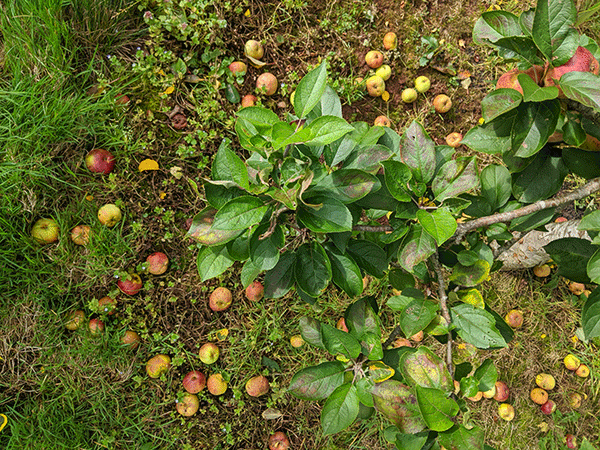“The best thing about cider is where you pick ‘off’ an eating apple from the tree, you pick ‘up’ a cider apple,” says Barny Butterfield, artisan cider maker and founder of Sandford Orchards in Devon. “We want the best flavour, and when the tree lets it go that’s when the apple has achieved its full flavour. It might be bruised and dirty, but it’s also fully ripe.”
He’s standing in a traditional cider orchard, a higgledy-piggledy collection of ancient apple trees, many of which produce unknown but uniquely flavourful cider apple varieties.
It’s a system which may not have changed since the Celts first made cider from crab apples, according to Butterfield, who points to a fallen apple tree still producing fruit. “Fallen trees become amazing habitats for things like earwigs, which snack on aphids. Or they are nesting places for birds and bats, so the caterpillars and moths will be kept under control,” he explains.
This kind of whole ecosystem health means traditional cider orchards don’t need to rely on chemical pesticides, while the fact they are processed means aesthetic blemishes, often the reason chemicals are sprayed on produce destined for eating, aren’t required at all.
But it’s the taste of a cider apple is where its real power lies. This is created by tannins, the source of other bitter flavours in things like marmalade, red wine and strong tea, and works both as a distinctive flavour and a natural preservative.

Small mixed family farms would each have their own cider orchard, and as a result, there are thousands of varieties specific to local areas. In Devon, these include names like Brown Snout, Tremlett’s Bitter or Yarlington Mill, and cider makers would blend multiple varieties that would all be found in one orchard. “Blended ciders are the character of an entire orchard in this part of the country. It’s an expression of Devon fruit, not dominated by a handful of industrially grown varieties,” says Butterfield, who is working with Bristol University to analyse the genes of apples and apple trees in his traditional orchards to identify some ancient varieties that aren’t officially known or used.
“Cider makers look for flavour over yield,” he says, explaining his search to rediscover ancient varieties as searching for “the Aretha Franklin in a mass choir”. “It used to be very secretive in terms of recipes. There were no cider brands because it was just another commodity like corn or potatoes. These are secrets held in the orchards, but luckily apple trees live a long time and their genetic DNA works like fingerprinting.”
Of course, growers need to be compensated fairly for keeping lower-yielding apple trees going for the benefit of flavour, and Sandford Orchards works with eight core growers as well as a group of smaller ones to pay over the industry average for their fruit. “We’re responsible for this orchard still existing and keeping the biodiversity intact,” says Butterfield.

Devon has a rich history of cidermaking, including Crediton, where there’s been a cider works (cider facility) for almost 100 years, and where Sandford Orchards now bottles its range including favourites Devon Red and Devon Mist. “People used to like cider and were good at making it here. The free-draining red soils of Crediton were really good for growing apples. There’s a history of great fruit production,” says Butterfield.
There would have been about 26,000 such orchards in the past in Devon, whereas now there are around 17,000 across the whole of the UK. Newer orchards are also now in the mix, designed in a vineyard-style to allow for more mechanisation.
Back at the packhouse, recycled rainwater floats the fruit gently into the building where any loose stones fall into a trap below, fruit is washed and then transported into the mill. Milled to a mush, the apples are then pumped into the press using air pressure (rather than the more industrial hydraulic pressure) and squashed, fermented and then left to mature.

All of that is par for the course in any decent cider-making enterprise, says Butterfield, who contrasts it to industrial alcohol brands where cider is mass produced and stored in large volumes until needed.
“The real secret is what apple are we using and how do we ferment it,” he explains, pointing to The General, the company’s largest vat made by hand in 1903, holding a huge 10,000 gallons, and infused with the flavours of every subsequent cider since.
“We ferment for flavour at a lower temperature,” says Butterfield, taking us past the shiny silver vats as the smell of apples follows us through from the mill. “It takes a couple of weeks to ferment but anything from six months up to three years to mature. In oak barrels you get the spritzy, vanilla flavours, while in The General you get a symphony of decades worth of cider flavours; it’s a natural biome.

Small-scale companies can often find innovative solutions and use by-products from other industries, and cider making is no different. Butterfield says Sandford was protected from the recent shortage of CO2 in the food and drink industry because the apple waste they produce goes into a biodigester to be converted into methane and CO2, which they then buy back and use in the cider. “We’re not having to buy CO2 from the fertiliser industry, which is a negative chain, so it’s a nice feeling,” he explains.
While many of us are now used to asking where our food comes from and how it was produced, it’s fair to say this hasn’t yet translated over to drinks – despite often involving many of the same farming systems. As Butterfield says: “Consumers haven’t quite got to the point of asking what’s in their cider, what apples are used and where do they come from? If they did that, the whole story of those big brands would unravel.”












I love real cider